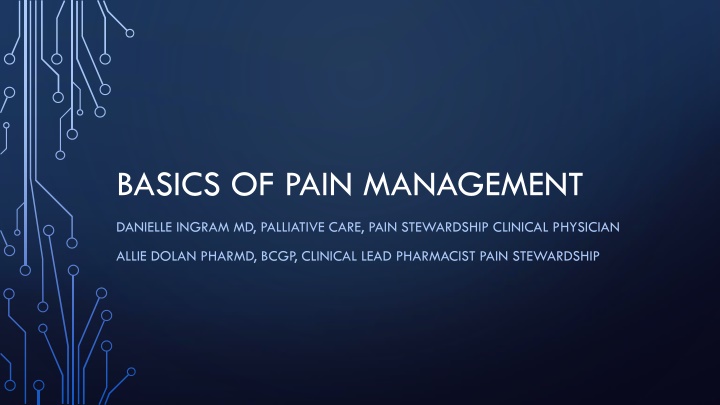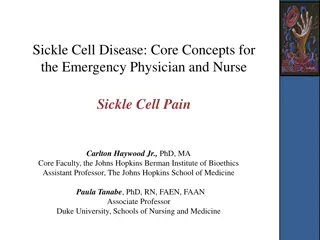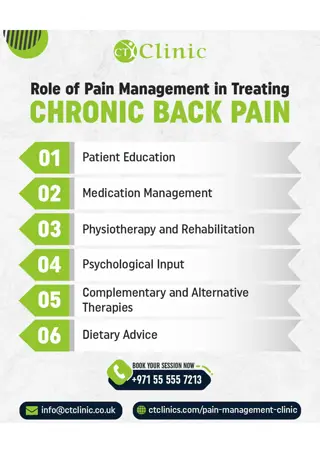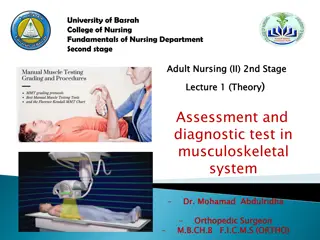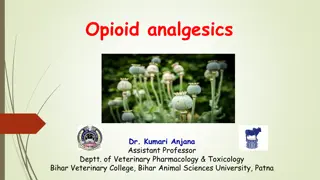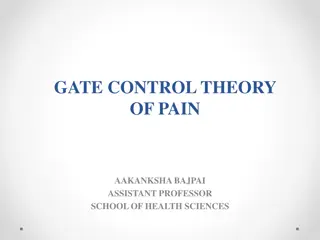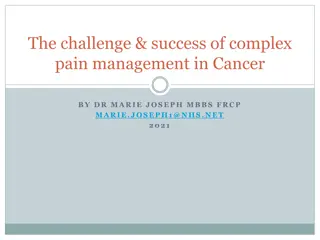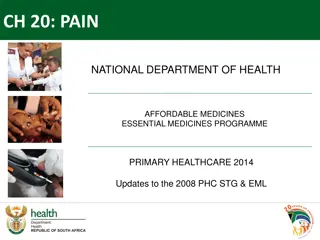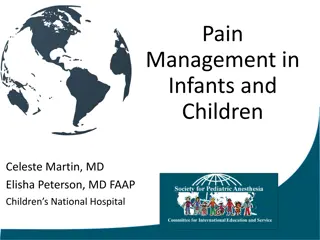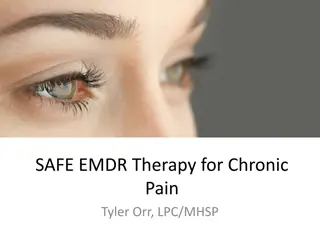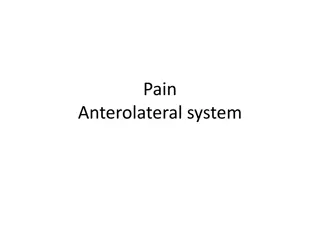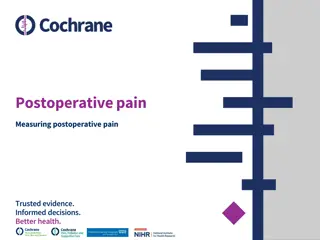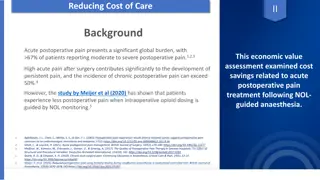Pain Management Essentials
Pain management basics and strategies introduced by Dr. Danielle Ingram, MD, and Clinical Pharmacist Allie Dolan, PharmD. Learn about the Pain Stewardship program, how to take a thorough pain history, non-pharmacologic and opioid pain management techniques, pain management procedures, and when to consult a specialist.
Download Presentation

Please find below an Image/Link to download the presentation.
The content on the website is provided AS IS for your information and personal use only. It may not be sold, licensed, or shared on other websites without obtaining consent from the author.If you encounter any issues during the download, it is possible that the publisher has removed the file from their server.
You are allowed to download the files provided on this website for personal or commercial use, subject to the condition that they are used lawfully. All files are the property of their respective owners.
The content on the website is provided AS IS for your information and personal use only. It may not be sold, licensed, or shared on other websites without obtaining consent from the author.
E N D
Presentation Transcript
BASICS OF PAIN MANAGEMENT DANIELLE INGRAM MD, PALLIATIVE CARE, PAIN STEWARDSHIP CLINICAL PHYSICIAN ALLIE DOLAN PHARMD, BCGP, CLINICAL LEAD PHARMACIST PAIN STEWARDSHIP
OBJECTIVES Introduce new Pain Stewardship program at Summa Review how to obtain a thorough pain history Review can t miss pain red flags Review basics of non-pharmacologic, non-opioid and opioid pain management techniques Review options for pain management procedures Discuss when and how to consult a pain management specialist
WHAT IS THE PAIN STEWARDSHIP PROGRAM? Physician Champion + Clinical Pharmacist Goal: Optimize care by focusing on appropriate strategies to manage pain while minimizing risk to our patients and community Identify patients at risk of adverse events, high opioid use, and/or with inadequate pain control and provide support and recommendations on approaches to care Provide guidance on pain management best practices, policy and regulatory compliance, and risk mitigation strategies
TAKING A PAIN HISTORY Precipitating and alleviating factors including prior treatments Quality describe the pain, ex. Sharp, dull, shooting Radiation where else does the pain go? Severity ask not only the current pain scale, but recent pain scales over several days and how it changes with medication doses. Not every patient can relate to a numbers scale! Timing constant? Intermittent or incident? Acute or chronic? Additional items: Location, associated symptoms(particularly red flag items, sudden or gradual onset, how has pain changed over time
WHAT IF MY PATIENT CANT OR WONT RATE THEIR PAIN? FACES pain scale Verbal descriptor scale asking the patient to choose from mild, discomforting, distressing, horrible, and excruciating Functional Questions effective analgesia is often defined as that which allows a patient to carry on more of their day to day activities Ask how the pain is affecting the following: Sleep Mood Relationships Ability to work or function
WHY AND HOW DO WE FEEL PAIN? Nociceptive (visceral, somatic)- a physiologic protective mechanism against noxious stimuli (i.e. hot, cold, sharp). This is a high-threshold pain activated by a noxious stimuli Inflammatory- caused by activation of the immune system by tissue injury or infection; this pain assists in healing by creating a situation that discourages physical contact and movement of the affected body part Pathological- pain that is maladaptive, resulting from abnormal functioning of the nervous system neuropathic or dysfunctional pain
Woolf CJ. What is this thing called pain? J Clin Invest. 2010 Nov;120(11):3742-4. doi: 10.1172/JCI45178. Epub 2010 Nov 1. PMID: 21041955; PMCID: PMC2965006.
RED FLAGS: WHEN MASKING THE PAIN IS DANGEROUS The following part of the presentation is interactive, for each body part/pain location we will review the biggest don t miss items which require further medical work-up as well as treatment of pain Work-up of potentially life-threatening and/or common sources of pain while managing symptoms is essential Please note this is not an exhaustive list, always exercise clinical judgement
DONT MISS! Acute Coronary Syndrome Pulmonary embolism Pericardial effusion, pericardial tamponade Acute aortic dissection Pneumothorax Esophageal perforation
DONT MISS! Acute appendicitis Acute cholecystitis Incarcerated hernia Ectopic pregnancy DKA Intra-abdominal abscess Obstructive process Acute pancreatitis AAA
DONT MISS Meningitis Discitis (fever, reasons for bacteremia including IVDA) Spinal hematoma (blood thinners, antiplatelets, recent surgery, trauma, epidural injection) Malignancy (age over 50, fever) Cauda equina syndrome (reduced anal sphincter tone, LE muscles weakness, saddle anesthesia, urinary retention) Spinal cord compression (hyperreflexia) Fracture
DONT MISS ACS (upper extremity) Acute limb ischemia Compartment syndrome Severe wound or infection Nerve impingement syndrome Acute fracture/dislocation or pathologic fracture
DONT MISS Retroperitoneal hemorrhage Acute pyelonephritis
DONT MISS Acute ICH, SAH Tumor/intracranial metastases Elevated ICP Meningitis
PAIN MANAGEMENT OPTIONS
NON-PHARMACOLOGIC PAIN MANAGEMENT Ice Heat Massage, Reiki Physical therapy Meditation, biofeedback Psychology, CBT Acupuncture Pain management procedures, palliative radiation therapy Spiritual care
PHARMACOLOGIC PAIN MANAGEMENT NON-OPIOID Indication Dosing examples Caution/contraindications Acetaminophen Mild to 1g PO BID-TID 650mg PO TID Max daily allowances (3g/day; 2g/day in liver disease, alcoholism) Opioid-APAP combination products (Percocet, Norco) CI: Severe hepatic impairment moderate pain NSAIDs Inflammatory pain Ketorolac 15mg IV Q6h PRN or ATC Ibuprofen 600mg PO Q6h PRN Naproxen 250- 500mg PO BID BBW: Serious GI events, cardiovascular thrombotic events CI: CABG surgery, heart failure, active GI bleeding Use caution in renal dysfunction, uncontrolled HTN, cardiac disease, elderly DDI: Avoid use in patients on blood thinners
PHARMACOLOGIC PAIN MANAGEMENT NON-OPIOID Neuropathic Agents Recommended starting dose Common side effects Caution/contraindications Gabapentin 100-300mg PO QHS Drowsiness, dizziness, edema, fatigue Dose adjustment in renal impairment Cautious use in patients with SUD history Potency: pregabalin > gabapentin Pregabalin 25-150mg/day SNRIs Duloxetine: 30mg PO daily 60mg daily Venlafaxine: 37.5-75mg/day Nausea, drowsiness, headache Duloxetine: Avoid use in hepatic impairment and CrCl<30mL/min Venlafaxine: Renal and hepatic dose adjustments TCAs 10-25mg PO QHS Anticholinergic, QT prolongation, sedation Drug interactions Caution in elderly
PHARMACOLOGIC PAIN MANAGEMENT NON-OPIOID Topical agents Lidocaine patch, cream Localized pain Muscle relaxants Baclofen, tizanidine Spasticity Methocarbamol, cyclobenzaprine Acute musculoskeletal pain ADEs: CNS depression, dizziness, anticholinergic effects Steroids Dexamethasone, prednisone Inflammatory pain ADEs: Hyperglycemia, GI effects, nervousness, adrenal suppression
OPIOIDS Place in therapy generally not first-line Dosing is highly individualized Patient factors Renal, hepatic function Adverse effects Common: Nausea/vomiting, drowsiness, constipation, dry mouth, hypogonadism Severe: Respiratory depression (BBW), delirium, hyperalgesia, addiction/abuse/misuse (BBW), withdrawal
OPIOID POTENCY Morphine 1mg Oxycodone 1mg Hydromorphone 1mg Equianalgesic dosing chart Hydrocodone/APAP (Norco) 5mg/325mg PO = Morphine 5mg PO Oxycodone/APAP (Percocet) 10mg/325mg >> Morphine 10mg PO Morphine 2mg IV < Oxycodone/APAP (Percocet) 5mg/325mg Hydromorphone 0.5mg IV Morphine 4mg IV
OPIOID DOSING Na ve dosing Tolerant dosing examples Dosage form examples Morphine 7.5mg PO Q4h PRN 2-4mg IV Q4h PRN 15mg PO Q4h PRN 4mg IV Q3h PRN IR tab: 15mg ER tab: 15mg, 30mg Injection: 4mg/mL Hydromorphone 1-2mg PO Q4h PRN 0.25-0.5mg IV Q4h PRN 4-8mg PO Q4h PRN 1mg IV Q3h PRN IR tab: 2mg, 4mg Injection: 1mg/mL Oxycodone 2.5-5mg PO Q4h PRN 10-15mg PO Q4h PRN IR tab: 5mg, 10mg, 20mg ER tab: 10mg, 15mg, 20mg Hydrocodone 5/325mg PO Q4h PRN Max: 9 of the 5/325mg tabs per day IR tab: 5/325mg, 10/325mg Fentanyl 25mcg IV Q1h PRN 50mcg IV Q1h PRN TD patch tolerant only Injection: 50mcg/mL Patch: 12mcg/h, 25mcg/h Tramadol 50mg PO Q6h PRN Max: 200-400mg/day IR tab: 50mg, 100mg
PAIN MANAGEMENT PROCEDURES (INPATIENT) Can often be done by interventional radiology! Sympathetic Blocks: Celiac plexus Peripheral nerve blocks: Intercostal nerve Pudendal nerve Ilioinguinal and iliohypogastric nerve Lateral femoral cutaneous nerve
OUTPATIENT PAIN MANAGEMENT PROCEDURES Epidural steroid injections Spine or peripheral joints RFA-radiofrequency ablation Intrathecal pain management pump Spinal cord stimulators
WHY THE DERMATOME MAP IS YOUR FRIEND Dermatomes. (2020, August 13). https://med.libretexts.org/@go/page/7 685. Dermatomes" by LibreTexts is licensed under CC BY-SA .
WHEN AND WHO TO CONSULT Acute Pain Service: non-malignant pain, post-operative pain Palliative Care: pain in the setting of either terminal or complex chronic illness, particularly if there is also need for goals of care discussion Interventional Radiology: for consideration of pain management procedure Pastoral Care: for any patient with spiritual or existential components to their pain Sub-specialist in area of body causing pain
COMPLYING WITH ORC WHEN WRITING OUTPATIENT PRESCRIPTIONS OARRS report: review and document Prior to prescribing any controlled substance At intervals no longer than 90 days Naloxone prescribing guidance History of prior opioid overdose >80 MED OR at lower doses if co-prescribed a CNS depressant Concurrent substance use disorder Underlying cardiopulmonary risk factors
COMPLYING WITH ORC WHEN WRITING OUTPATIENT PRESCRIPTIONS (CONT.) Opioid prescribing requirements for chronic pain History, physical exam, lab/diagnostic testing, OARRS review, pain assessment Complete and routinely update treatment plan Counsel/discuss benefits and risks of opioid therapy consider naloxone Prescribing 80 MED Complete and maintain written pain treatment agreement and informed consent Offer prescription for naloxone Consider consultation with specialist Shall not prescribe >120 MED
RESOURCES 1. The Massachusetts General Hospital Handbook of Pain Management 4th Edition. Brenner, Gary J. M.D. and James P. Rathmell, MD. Wolters Kluwer. 2021 2. Woolf CJ. What is this thing called pain? J Clin Invest. 2010 Nov;120(11):3742-4. doi: 10.1172/JCI45178. Epub 2010 Nov 1. PMID: 21041955; PMCID: PMC2965006. 3. Dowell D, Haegerich TM, Chou R. CDC Guideline for Prescribing Opioids for Chronic Pain United States, 2016. MMWR Recomm Rep 2016;65(No. RR-1):1 49. doi: http://dx.doi.org/10.15585/mmwr.rr6501e1 4. Ohio Revised Code 4731.055; Ohio Revised Code 4731.052. 5. Ohio Administrative Code Chapter 4731-11.
ADDITIONAL REFERENCES 1. 2. Tauben D. Nonopioid Medications for Pain. Phys Med Rehabil Clin N Am. 2015:26(2);219 248 Lexicomp Online [Internet]. Hudson (OH): Wolters Kluwer Health; c1978-2021 [cited 10 Dec 2021]. Available from: https://online.lexi.com/lco/action/home. 3. Finnerup NB, Sindrup SH, and Jensen TS. The evidence for pharmacological treatment of neuropathic pain. Pain. 2010; 150: 573 581. 4. O Connor AB, Dworkin RH. Treatment of neuropathic pain: an overview of recent guidelines. Am J Med. 2009 Oct;122(10 Suppl):S22-32. 5. 6. 7. Ohio Admin. Code 4731-11-01 (2020). Ohio Admin. Code 4731-11-11 (2021). State Medical Board of Ohio, State of Ohio Board of Pharmacy, and Ohio Board of Nursing. (2015). Naloxone Joint Regulatory Statement. Retrieved from: https://nursing.ohio.gov/wp-content/uploads/2019/08/Naloxone_Joint_Regulatory_ Statement_2015_5.1.pdf. 8. Ohio Admin. Code 4731-11-14 (2020).
CONTACT INFO Danielle Ingram, MD Desk phone: 330-375-6750 Cell phone: 330-389-1365 Email: ingramd@summahealth.org *And on PerfectServe! Allie Dolan, PharmD, BCGP Desk phone: 330-375-7135 Cell phone: 330-933-2585 Email: dolana@summahealth.org
